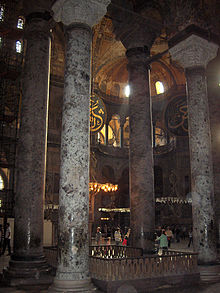Verd antique
It is a dark, dull green, white-mottled (or white-veined) serpentine, mixed with calcite, dolomite, or magnesite, which takes a high polish.
[3] Non-brecciated varieties of a very similar serpentinite, sometimes also called "verd antique", have been quarried at Victorville, California;[4] Cardiff, Maryland;[5] Holly Springs, Georgia;[6] and Rochester in Addison County, Vermont.
[7] Verd antique is used like marble especially in interior decoration and occasionally as outdoor trim, although the masses are frequently jointed and often only small slabs can be secured.
Columns, ambons, iconostasis, and fonts of verd antique are found in the Church of the Acheiropoietos, Hagios Demetrios, and Hagia Sophia, Thessaloniki.
In ancient Neapolis, a Thessalian stone outside a church dedicated to Saint Nicholas is said to mark where the Apostle Paul disembarked for Philippi.
[9] Thirteen Roman imperial sarcophagi of the Byzantine period were of verd antique, according to the Patria Constantinopoleos and the works of Constantine VII Porphyrogenitus.


